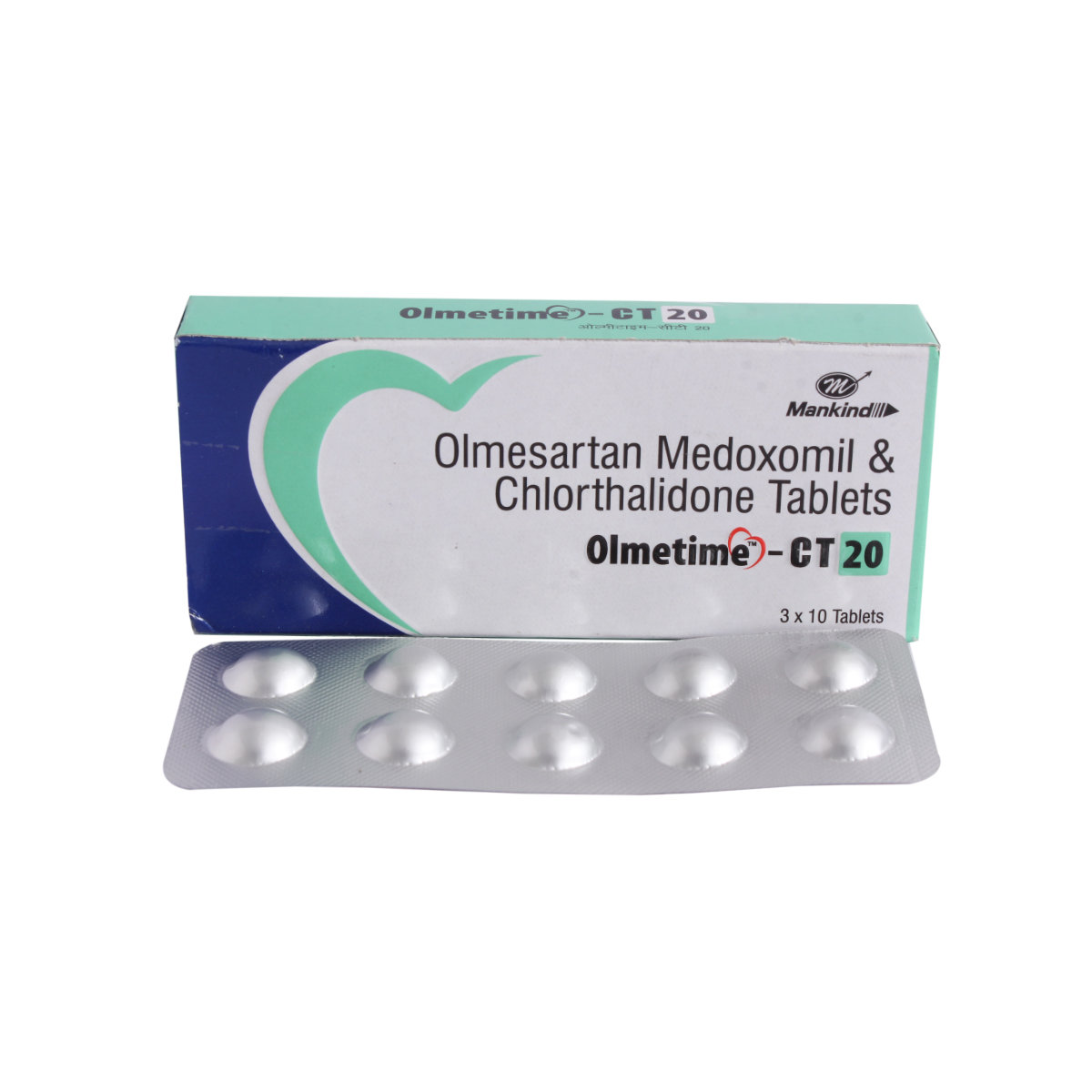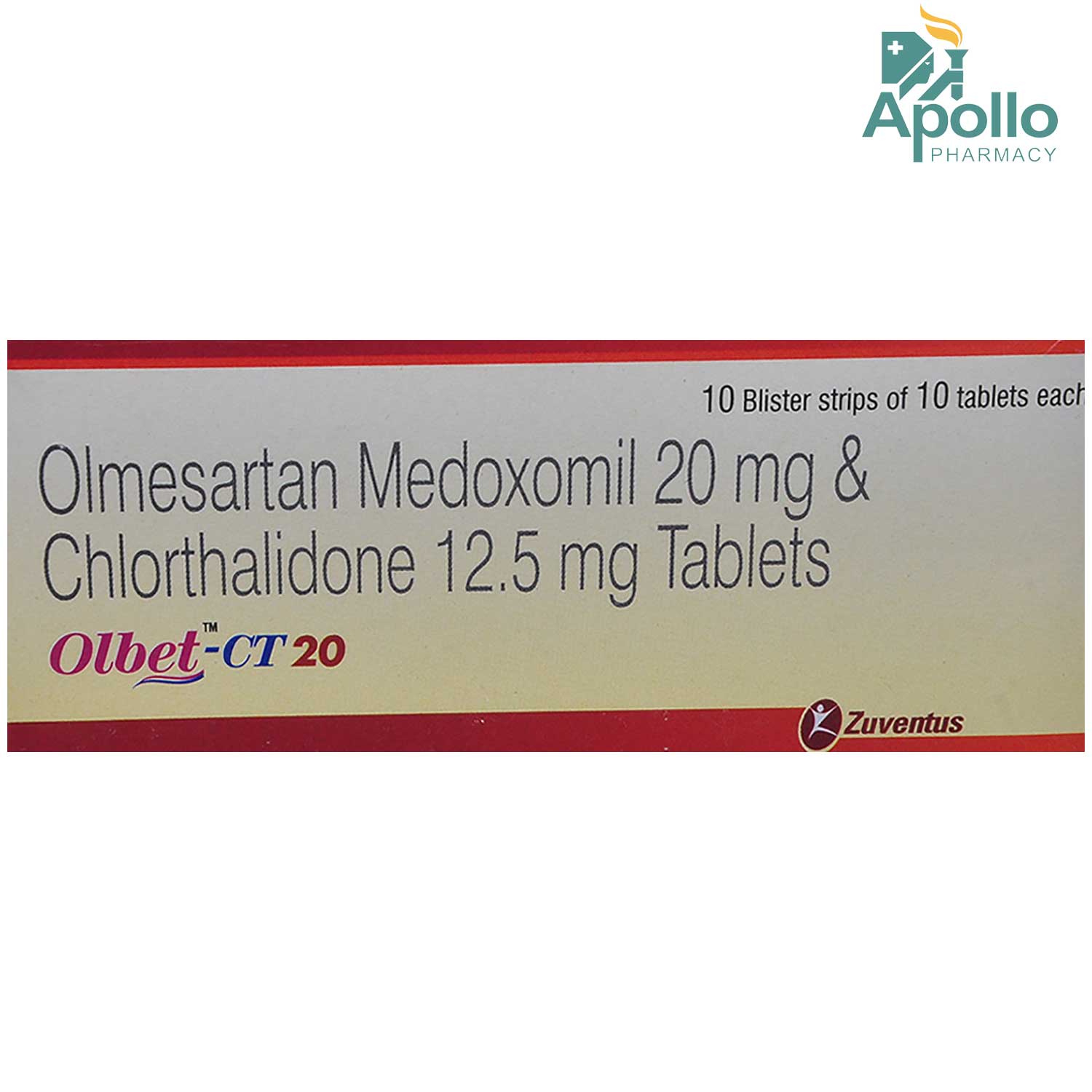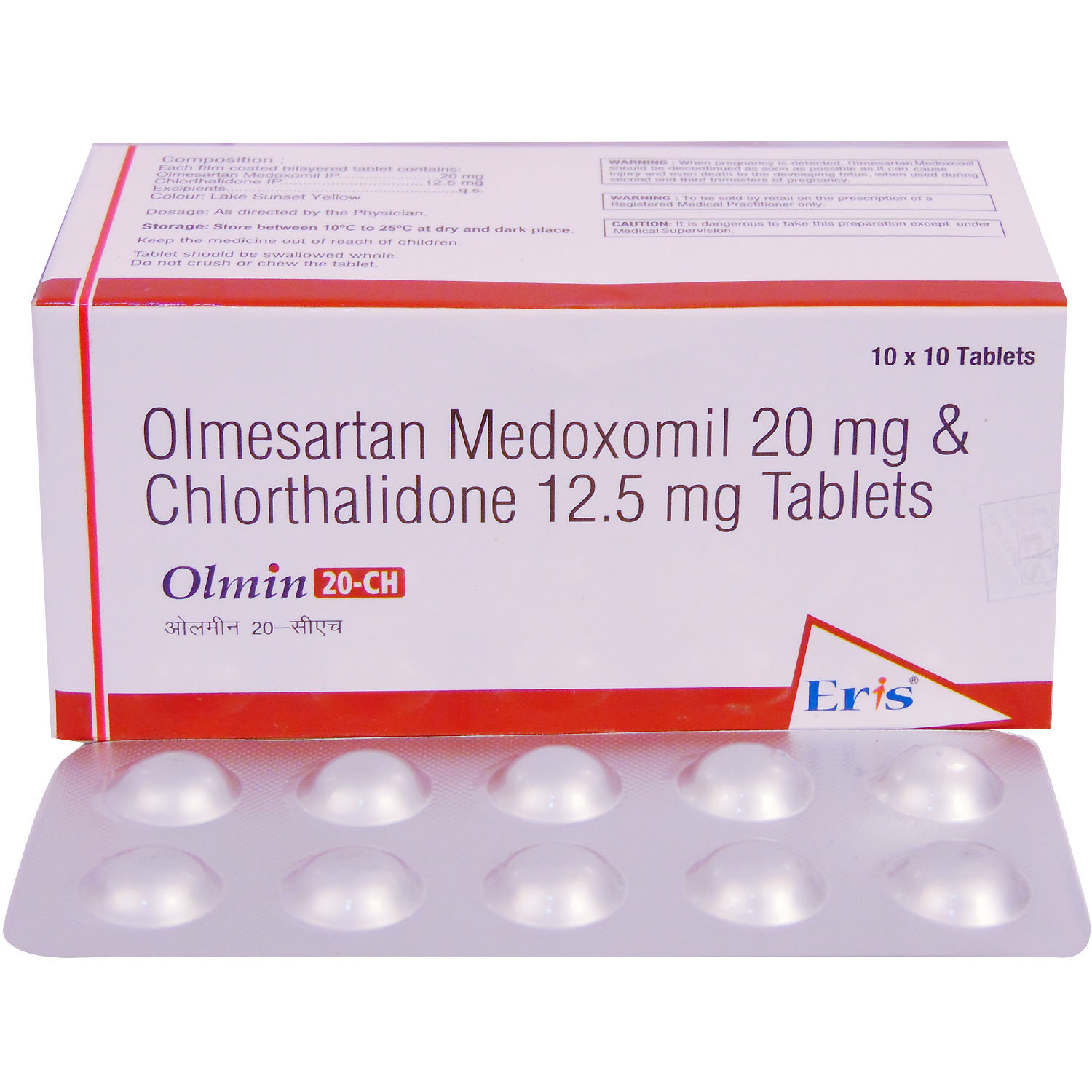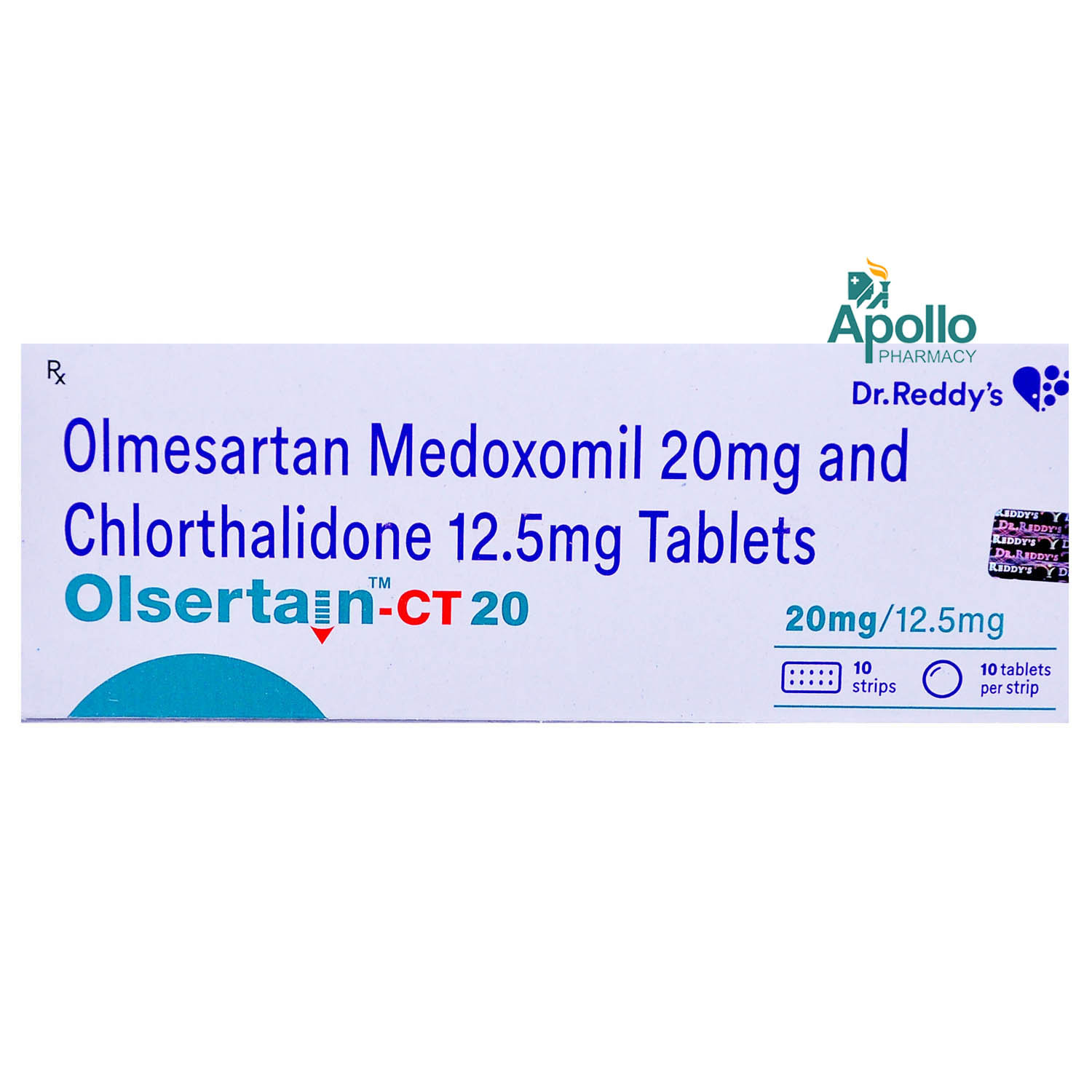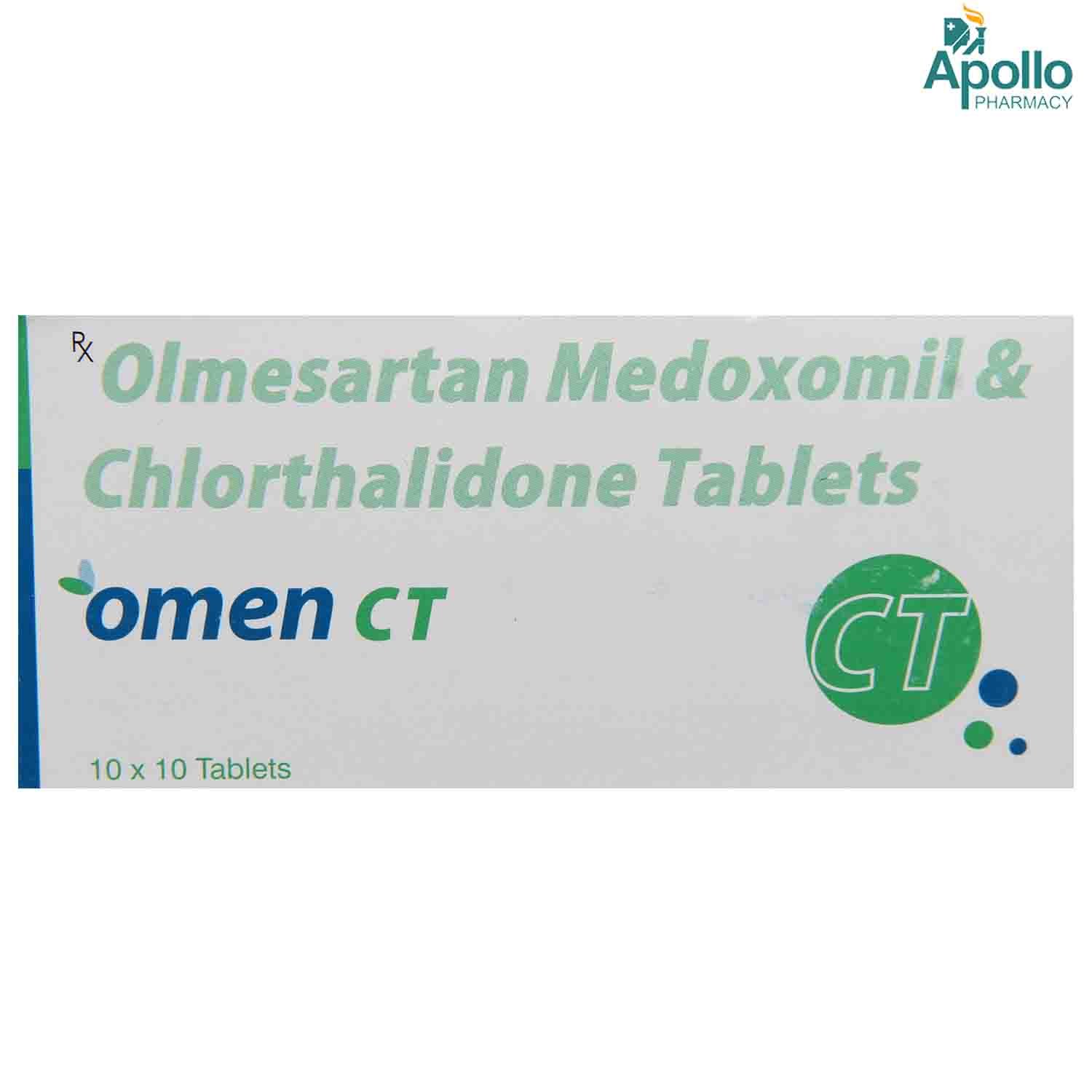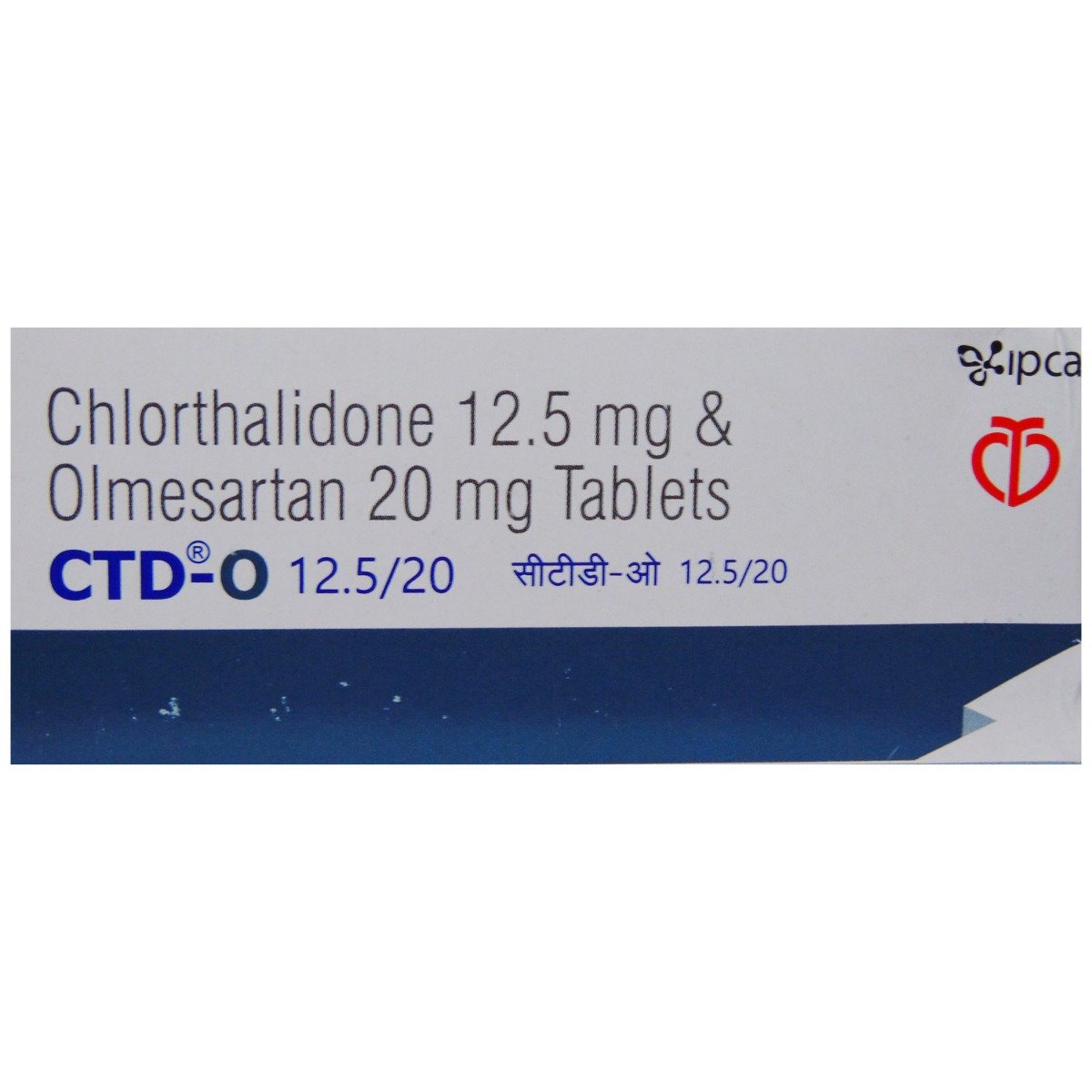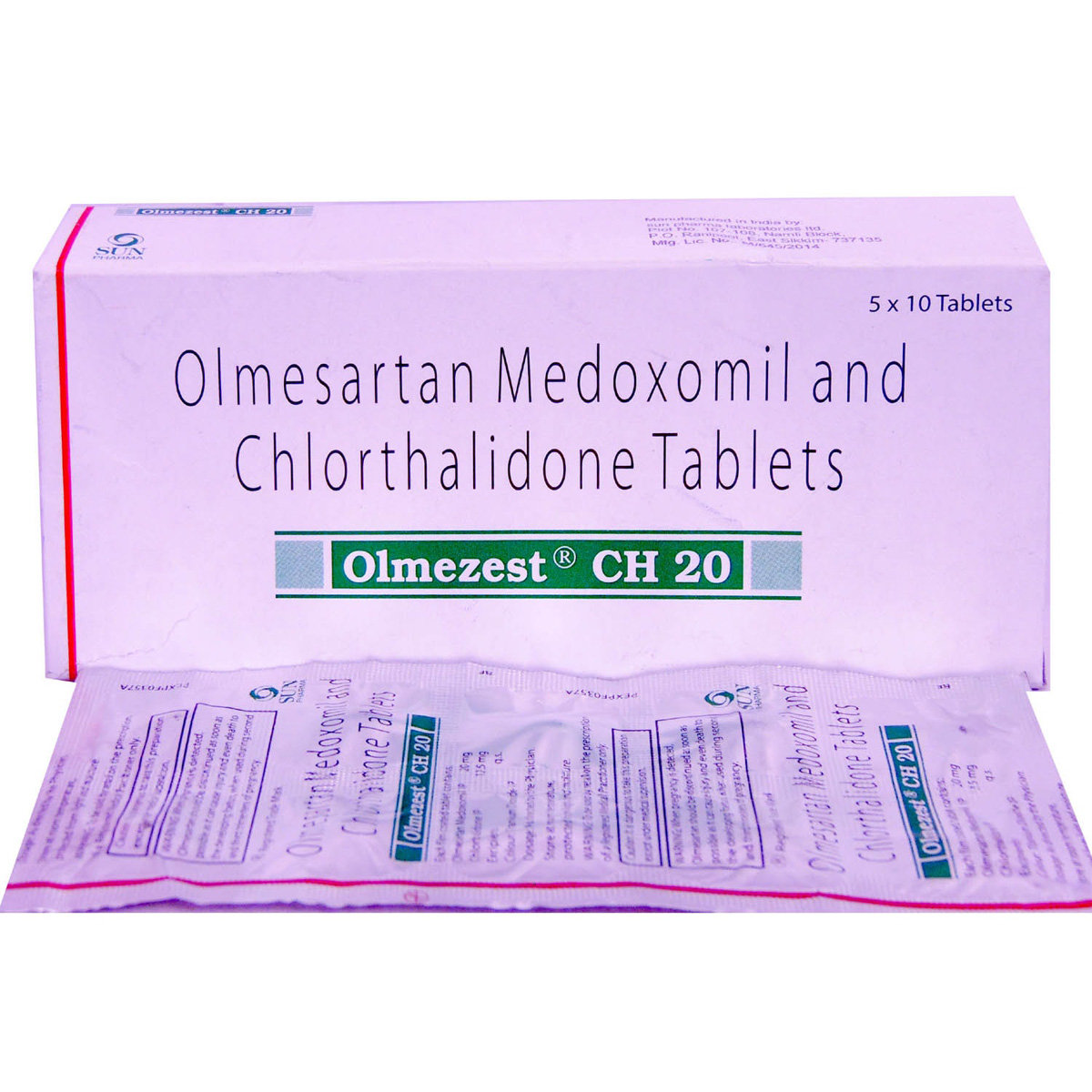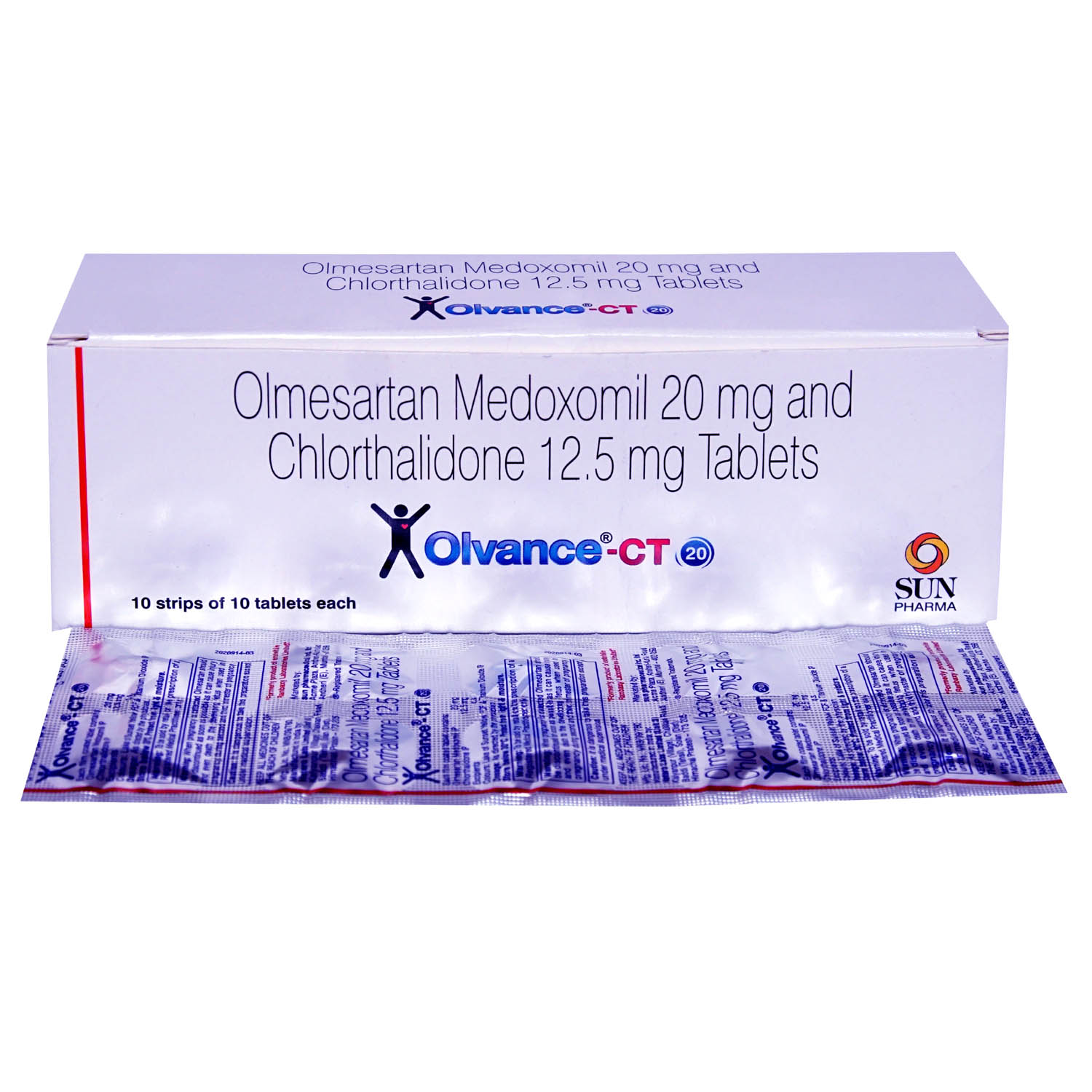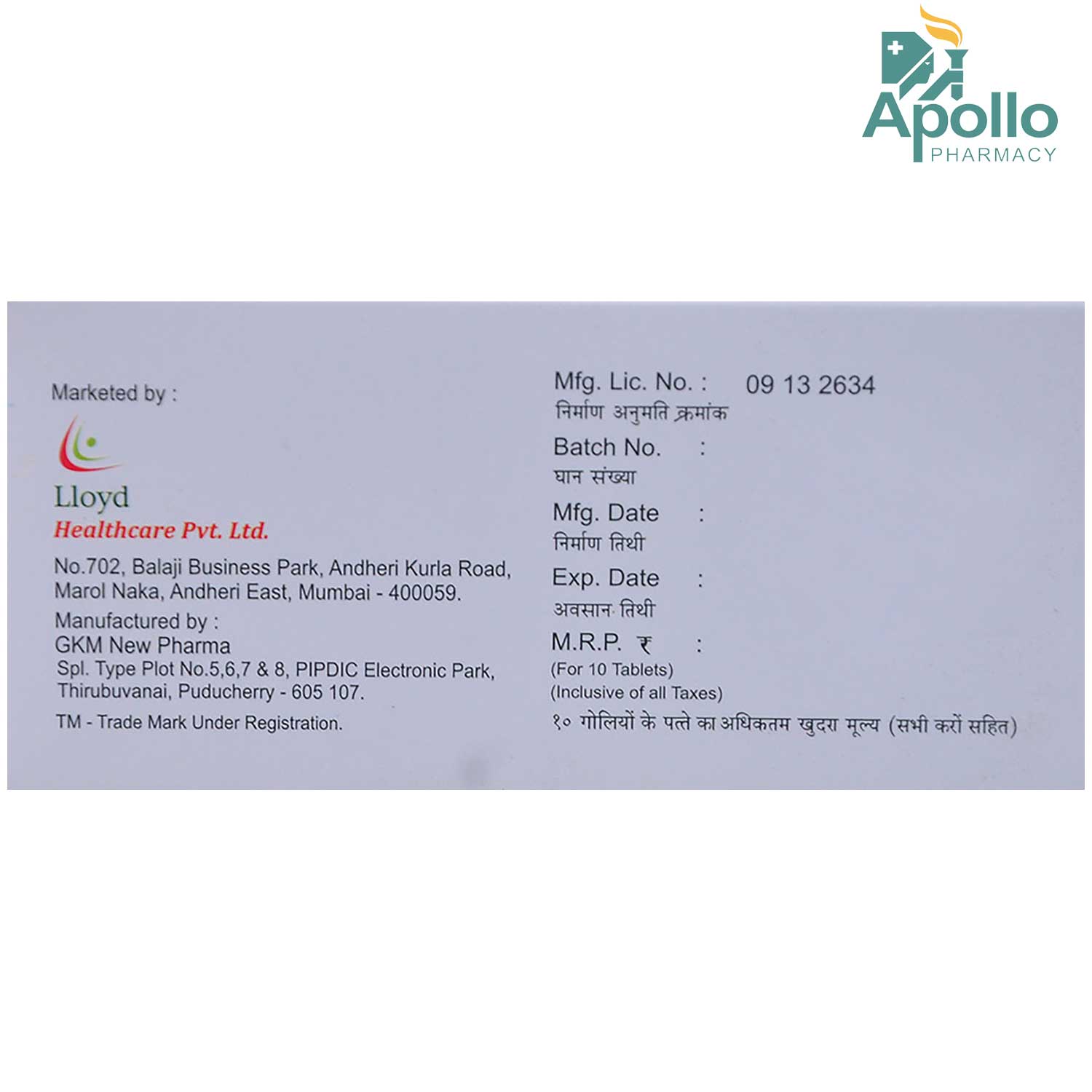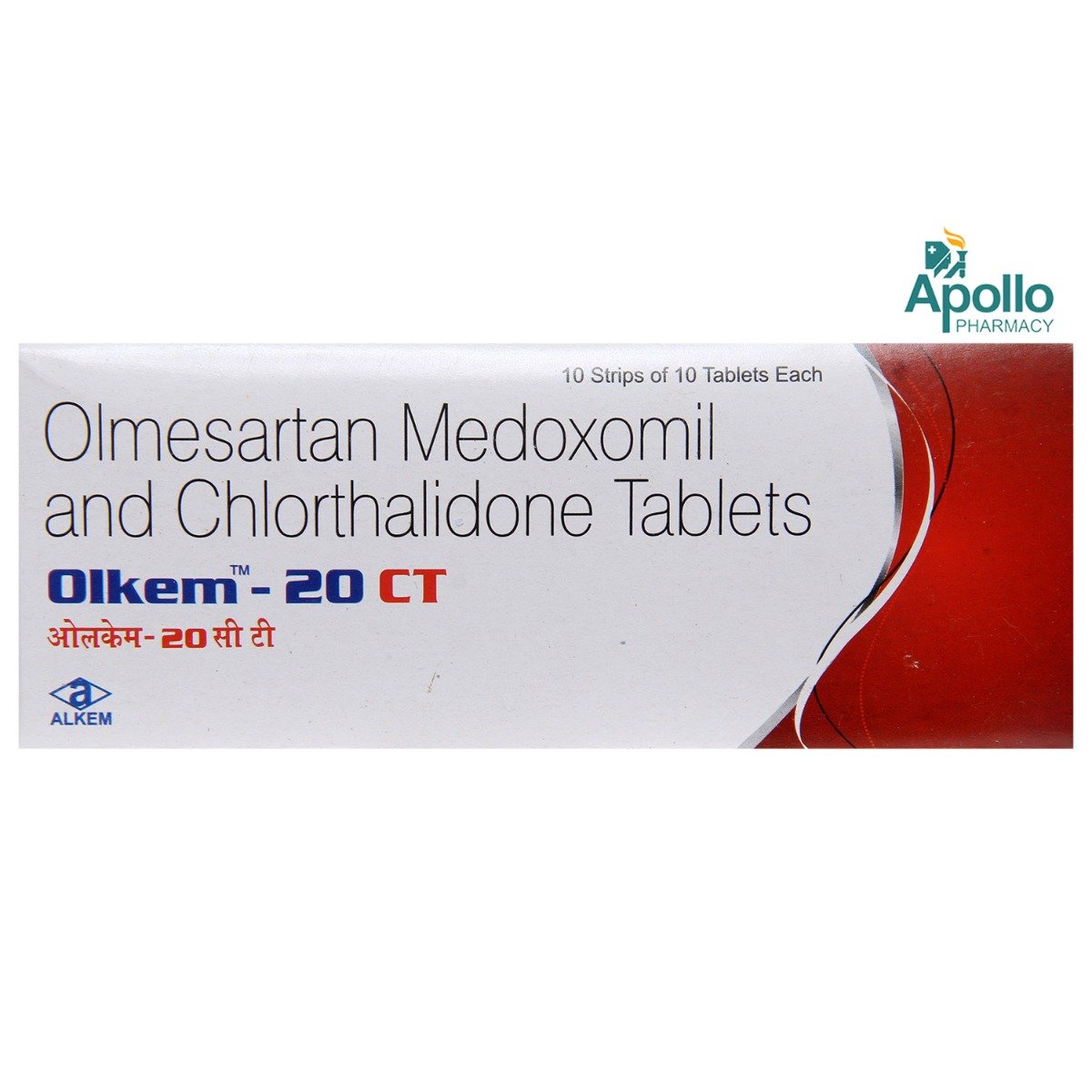Olmat 20 CT Tablet 10's
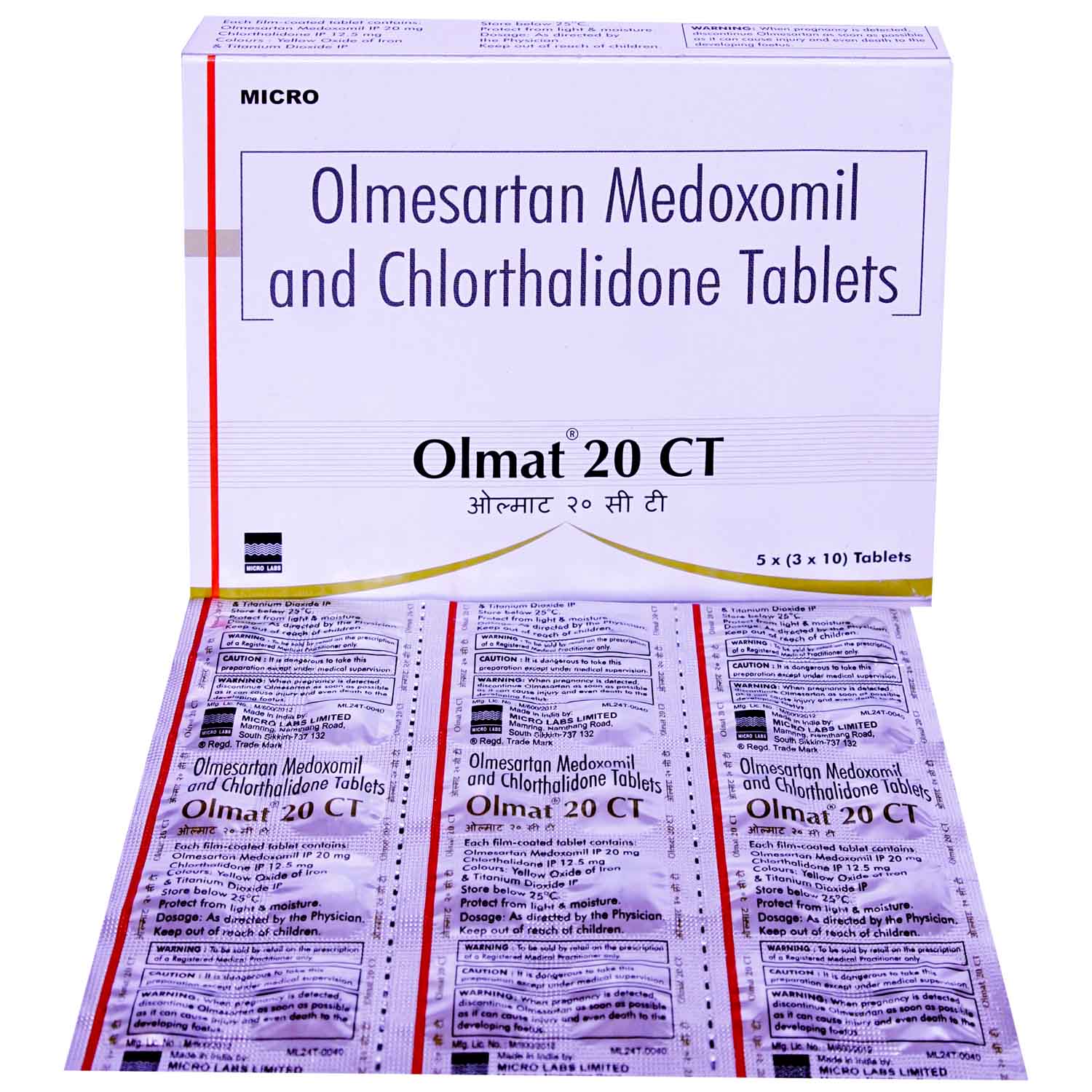
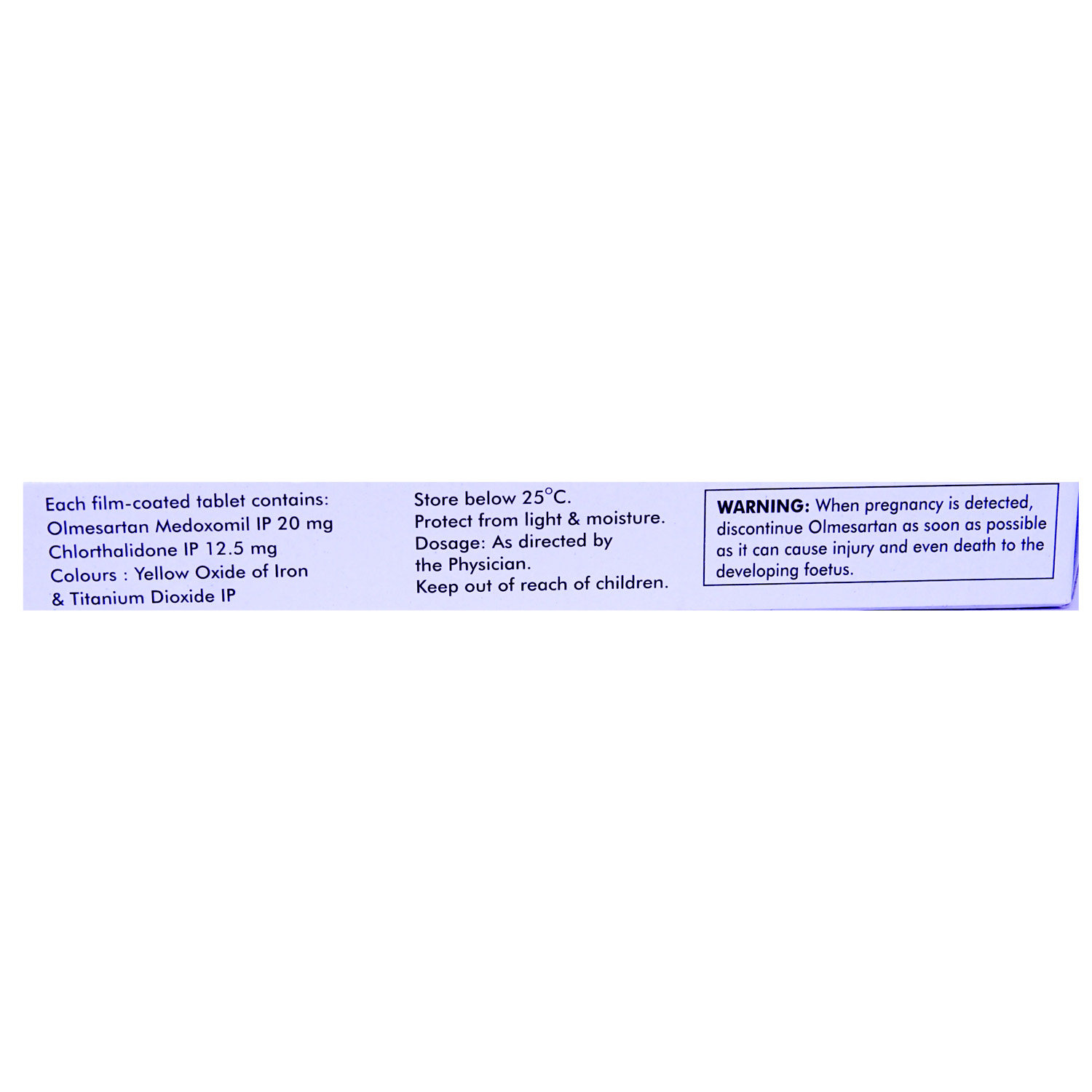
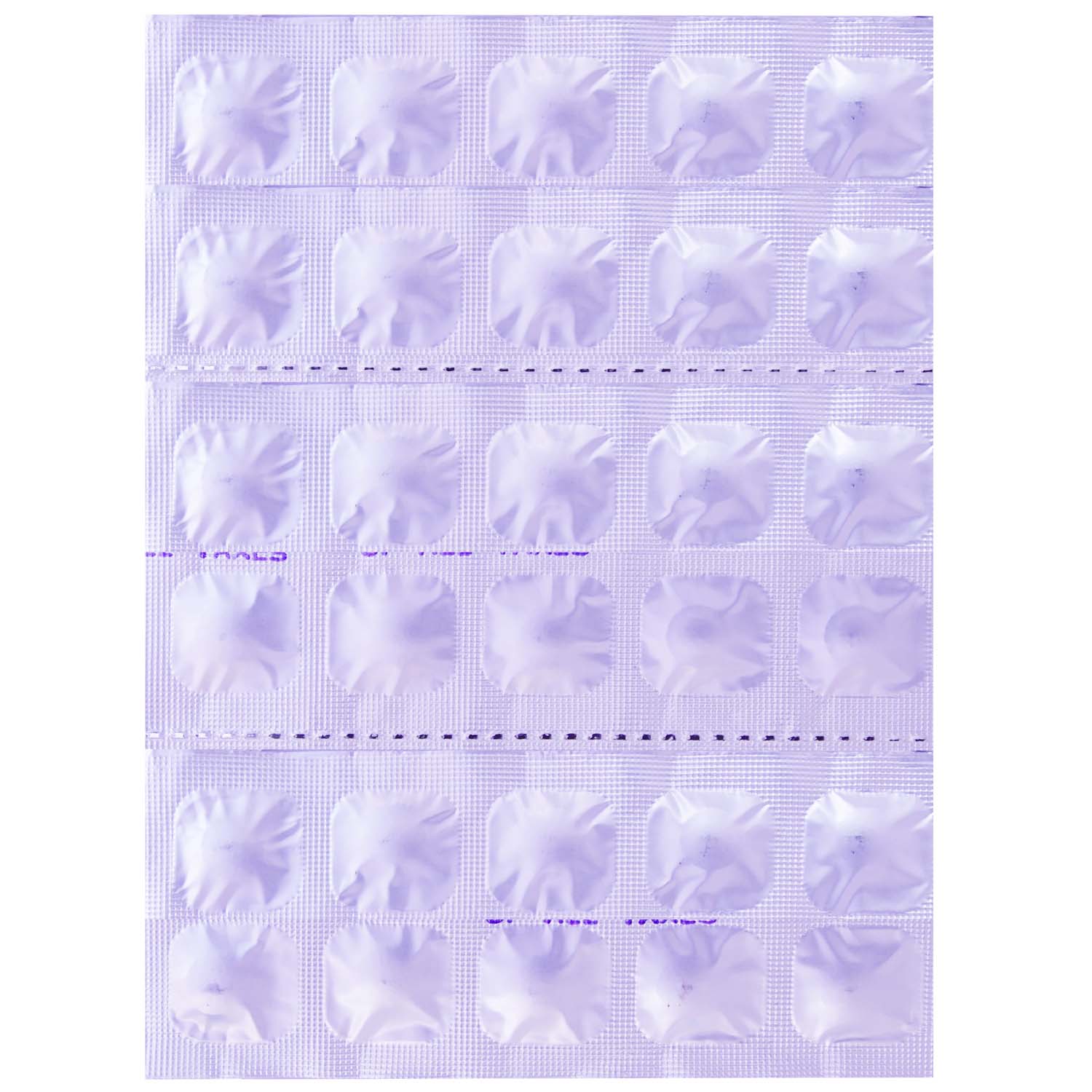



MRP ₹208
(Inclusive of all Taxes)
₹31.2 Cashback (15%)
Selected Pack Size:10
10 ₹187.2
(₹18.72 per unit)
In Stock
15 ₹171
(₹11.4 per unit)
In Stock
Provide Delivery Location
Online payment accepted
 Prescription drug
Prescription drugWhats That
Composition :
Manufacturer/Marketer :
Consume Type :
Return Policy :
Expires on or after :
About Olmat 20 CT Tablet
Olmat 20 CT Tablet belongs to the class of medicines called antihypertensives primarily used to treat high blood pressure. Hypertension or high blood pressure is a chronic condition in which the force exerted by the blood against the artery wall is high. As a result, it leads to heart diseases, irregular heartbeat, and other complications.
Olmat 20 CT Tablet is a combination of two medicines namely: Olmesartan medoxomil and Chlorthalidone. Olmesartan medoxomil is an angiotensin receptor blocker (ARB) which works by blocking the hormone angiotensin, thereby relaxing blood vessels. This allows the blood to flow more smoothly and the heart to pump more efficiently. Chlorthalidone is a diuretic or water pills that removes extra water and certain electrolytes from the body. Together it lowers fluid overload, blood pressure and improves blood flow.
You can take Olmat 20 CT Tablet with food or without food. It should be swallowed whole with a glass of water. Do not chew, bite, or break it. Your doctor will advise you how often you take your tablets based on your medical condition. In some cases, you may experience headache, nausea, or dizziness. Most of these side effects of Olmat 20 CT Tablet do not require medical attention and gradually resolve over time. However, if the side effects are persistent, reach out to your doctor.
Try not to stop taking this medicine of your own. Let your doctor know about this, as it may cause a rise in blood pressure and can increase the risk of getting heart diseases and stroke. Inform your doctor if you are suffering from any kidney or liver or heart disease or are diabetic. If you are pregnant or breastfeeding, please tell your doctor so that the dosage of Olmat 20 CT Tablet can be prescribed accordingly. Do not use Olmat 20 CT Tablet if you are unable to urinate, are dehydrated, have low blood pressure (hypotension), cardiogenic shock (sudden stopping of blood flow to the heart). Please tell your doctor if you are taking any other medicines or are allergic to this medicine. Reducing the amount of table salt (sodium chloride) in your food often relieves the swelling of the body.
Uses of Olmat 20 CT Tablet
Directions for Use
Medicinal Benefits
Olmat 20 CT Tablet is a combination medication, generally used when a single medicine is not effective in controlling blood pressure. Olmat 20 CT Tablet is used to treat hypertension, where Olmesartan medoxomil works by relaxing the blood vessels. On the other hand, Chlorthalidone being diuretic works by increasing the amount of urine that is passed out from the kidneys and hence lowering the blood pressure. Together it lowers the overall raised blood pressure and reduces the risk of having a heart attack, stroke, or kidney problems.
Storage
- Talk to your doctor about oral potassium supplements.
- Eat potassium rich foods such as bananas, avocados, oranges, dark leafy greens, beans and peas, fish, spinach, milk and tomatoes.
- Limit intake of full-fat dairy products, red meat and processed foods rich in saturated fats.
- Avoid foods with label “partially hydrogenated oils”.
- Eat more vegetables, fruits, oats, whole grains, lentils and beans to increase fiber intake.
- Include foods rich in monounsaturated fats like nuts, avocados, olive oil, and oily fish.
- Limit consumption of egg yolks.
- Exercise for at least 30 minutes 5 days a week.
- Aim for weight loss and maintain healthy weight.
- Quit smoking as smoking raises the risk of heart disease associated with cholesterol.
- Limit alcohol consumption as excessive drinking may raise cholesterol levels.
- Inform your doctor about dizziness symptoms. They may adjust your medication regimen or prescribe additional medications to manage symptoms.
- Follow your doctor's instructions for taking medication, and take it at the same time every day to minimize dizziness.
- When standing up, do so slowly and carefully to avoid sudden dizziness.
- Avoid making sudden movements, such as turning or bending quickly, which can exacerbate dizziness.
- Drink plenty of water throughout the day to stay hydrated and help alleviate dizziness symptoms.
- If you're feeling dizzy, sit or lie down and rest until the dizziness passes.
- Track when dizziness occurs and any factors that may trigger it, and share this information with your doctor to help manage symptoms.
- If you experience symptoms like coughing, wheezing, chest tightness, or difficulty breathing after taking medication, seek medical attention immediately.
- Your healthcare provider will work with you to stop the medication causing the reaction, start alternative treatments, and provide supportive therapy.
- To manage symptoms and prevent complications, follow your doctor's advice to use inhalers or nebulizers as prescribed, practice good hygiene, avoid irritants, stay hydrated, and get plenty of rest.
- Regularly track your symptoms and report any changes or concerns to your healthcare provider.
- Inform Your Doctor: Notify your doctor immediately about your diarrhoea symptoms. This allows them to adjust your medication or provide guidance on managing side effects.
- Stay Hydrated: Drink plenty of fluids to replace lost water and electrolytes. Choose water, clear broth, and electrolyte-rich drinks. Avoid carbonated or caffeinated beverages to effectively rehydrate your body.
- Follow a Bland Diet: Eat easy-to-digest foods to help firm up your stool and settle your stomach. Try incorporating bananas, rice, applesauce, toast, plain crackers, and boiled vegetables into your diet.
- Avoid Trigger Foods: Steer clear of foods that can worsen diarrhoea, such as spicy, fatty, or greasy foods, high-fibre foods, and dairy products (especially if you're lactose intolerant).
- Practice Good Hygiene: Maintain good hygiene to prevent the spread of infection. To stay healthy, wash your hands frequently, clean and disinfect surfaces regularly, and avoid exchanging personal belongings with others.
- Take Anti-Diarrheal Medications: If your doctor advises, anti-diarrheal medications such as loperamide might help manage diarrhoea symptoms. Always follow your doctor's directions.
- Keep track of your diarrhoea symptoms. If they don't get better or worse or are accompanied by severe stomach pain, blood, or dehydration signs (like extreme thirst or dark urine), seek medical help.
- Talk to your doctor about your back pain and potential medication substitutes or dose changes.
- Try yoga or Pilates and other mild stretching exercises to increase flexibility and strengthen your back muscles.
- To lessen the tension on your back, sit and stand upright and maintain proper posture.
- To alleviate discomfort and minimize inflammation, apply heat or cold packs to the afflicted area.
- Under your doctor's supervision, think about taking over-the-counter painkillers like acetaminophen or ibuprofen.
- Make ergonomic adjustments to your workspace and daily activities to reduce strain on your back.
- To handle tension that could make back pain worse, try stress-reduction methods like deep breathing or meditation.
- Use pillows and a supportive mattress to keep your spine in the right posture as you sleep.
- Back discomfort can worsen by bending, twisting, and heavy lifting.
- Speak with a physical therapist to create a customized training regimen to increase back strength and flexibility.
Drug Warnings
Olmat 20 CT Tablet should not be given to the people allergic to Olmat 20 CT Tablet , have low blood pressure (less than 90 mm of Hg), have had a heart attack, kidney disease, liver disease, pregnant women, or planning to get pregnant and breastfeeding women. Besides this, it is contraindicated in low blood pressure (hypotension), cardiogenic shock (sudden stopping of blood flow to the heart), and aortic stenosis (heart valve problem). Olmat 20 CT Tablet can pass into breast milk, but its effect on the baby is not known. So, it is better to tell your doctor if you are taking Olmat 20 CT Tablet and breastfeeding.
Drug-Drug Interactions
Drug-Drug Interactions
Login/Sign Up
Using aliskiren together with olmesartan may increase the risk of serious side effects (kidney problems, low blood pressure, and high potassium levels in the blood).
How to manage the interaction:
Taking Olmat 20 CT Tablet with Aliskiren is not recommended as it can cause an interaction, they can be taken if advised by a doctor. You should seek medical attention if you experience nausea, vomiting, weakness, confusion, tingling of the hands and feet, feelings of heaviness in the legs, a weak pulse, or a slow or irregular heartbeat.It is crucial that you continue to consume enough fluids while taking these medications. Do not stop using any medications without consulting a doctor.
Co-administration of Olmat 20 CT Tablet and cisapride may increase the risk or severity of an irregular heart rhythm that may be serious.
How to manage the interaction:
Taking Olmat 20 CT Tablet with Cisapride is not recommended, please consult your doctor before taking it. Do not discontinue the medication without consulting a doctor.
Coadministration of Olmat 20 CT Tablet with fosinopril may cause low blood pressure, kidney problems, and may increase potassium levels in the blood.
How to manage the interaction:
Although taking Olmat 20 CT Tablet together with fosinopril may lead to an interaction but can be taken if prescribed by the doctor. However, consult the doctor if you experience nausea, vomiting, weakness, disorientation, tingling in your hands and feet, feelings of heaviness in your legs, a weak pulse, or a slow or irregular heartbeat. Do not stop using any medications without talking to a doctor.
Coadministration of Olmat 20 CT Tablet may increase potassium levels in the blood, which can lead to kidney failure, muscular paralysis, and abnormal heart rhythm.
How to manage the interaction:
Although taking Olmat 20 CT Tablet together with potassium citrate may result in an interaction, they can be taken together if prescribed by your doctor. However, consult the doctor if you experience nausea, vomiting, weakness, disorientation, tingling in your hands and feet, feelings of heaviness in your legs, a weak pulse, or a slow or irregular heartbeat. It is essential to maintain proper fluid intake while taking these medications. Do not discontinue any medications without a doctor's advice.
Coadministration of Olmat 20 CT Tablet with enalapril can elevate the risk of adverse effects such as low blood pressure, kidney impairment, and hyperkalemia (high blood potassium). Hyperkalemia can cause kidney failure, strong paralysis, abnormal heart rhythm, and cardiac arrest in extreme instances. If you are elderly, dehydrated, or have renal disease, diabetes, or severe heart failure, you are more prone to develop hyperkalemia while taking these medications.
How to manage the interaction:
Although taking Olmat 20 CT Tablet together with enalapril may result in an interaction, they can be taken together if prescribed by your doctor. However, contact your doctor immediately if you experience signs and symptoms of hyperkalemia, such as nausea, vomiting, confusion, numbness, tingling in hands and feet, and irregular heartbeat. It is advised to limit the intake of potassium-rich foods like tomatoes, bananas, mangoes, beans, and potassium-containing supplements. Do not discontinue any medication without consulting your doctor.
Taking ramipril together with olmesartan may increase the risk of side effects (blood pressure, kidney function impairment, and a condition called Hyperkalemia - high blood potassium).
How to manage the interaction:
Although taking Olmat 20 CT Tablet with ramipril may lead to an interaction but can be taken if prescribed by the doctor. However, consult the doctor if you experience nausea, vomiting, weakness, disorientation, tingling in your hands and feet, feelings of heaviness in your legs, a weak pulse, or a slow or irregular heartbeat. Do not stop using any medications without talking to a doctor.
Olmat 20 CT Tablet when combined with benazepril may cause low blood pressure, kidney problems, and may increase potassium levels in the blood.
How to manage the interaction:
Although taking Olmat 20 CT Tablet with benazepril may lead to an interaction but can be taken if prescribed by the doctor. However, consult the doctor if you experience nausea, vomiting, weakness, disorientation, tingling in your hands and feet, feelings of heaviness in your legs, a weak pulse, or a slow or irregular heartbeat. Do not stop using any medications without talking to a doctor.
Taking Amiloride with Olmat 20 CT Tablet can elevate potassium levels in the blood. (High potassium levels can cause hyperkalemia, which can lead to kidney failure, muscular paralysis, abnormal heart rhythm, and cardiac arrest in extreme cases).
How to manage the interaction:
Although taking amiloride with Olmat 20 CT Tablet may lead to an interaction but can be taken if prescribed by the doctor. However, consult the doctor if you experience nausea, vomiting, weakness, disorientation, tingling in your hands and feet, feelings of heaviness in your legs, a weak pulse, or a slow or irregular heartbeat. It is important to maintain proper fluid intake while taking these medications. Do not stop using any medications without talking to a doctor.
Taking lithium with Olmat 20 CT Tablet may significantly increase the blood levels of lithium .
How to manage the interaction:
Although taking Olmat 20 CT Tablet alongside lithium can lead to interaction, they can be taken if prescribed by a doctor. However, if you develop sleepiness, dizziness, confusion, loose stools, vomiting, muscular weakness, muscle incoordination, a shaking sensation, blurred vision, ringing in the ears, excessive thirst, and/or increased urination, consult a doctor. Do not stop using any medications without talking to a doctor.
Taking Olmat 20 CT Tablet with trimethoprim may increase potassium levels in the blood.
How to manage the interaction:
Although taking Olmat 20 CT Tablet with trimethoprim may lead to an interaction but can be taken if prescribed by the doctor. However, consult the doctor if you experience nausea, vomiting, weakness, disorientation, tingling in your hands and feet, feelings of heaviness in your legs, a weak pulse, or a slow or irregular heartbeat. Do not stop using any medications without talking to a doctor.
Drug-Food Interactions
Drug-Food Interactions
Login/Sign Up
Lentils, Orange Juice, Oranges, Raisins, Potatoes, Salmon Dried, Spinach, Sweet Potatoes, Tomatoes, Coconut Water, Beans, Beetroot, Broccoli, Bananas, Apricots, Avocado, Yogurt
How to manage the interaction:
When Olmat 20 CT Tablet is taken along with potassium-containing salt substitutes or over-the-counter potassium supplements it may lead to high potassium levels in blood. Avoid taking potassium-containing salt substitutes or over-the-counter potassium supplements with Olmat 20 CT Tablet as this can lead to high potassium levels in the blood. However, consult a doctor if you experience weakness, irregular heartbeat, confusion, tingling of the extremities, or feelings of heaviness in the legs.
Diet & Lifestyle Advise
- Keep your weight under control with BMI 19.5-24.9.
- Do regular physical activity or exercise for at least 150 minutes per week, or about 30 minutes most days of the week. Doing this can help you to lower your raised blood pressure by about 5 mm of Hg.
- Opt for a diet rich in whole grains, fruits, veggies, and low-fat dairy products.
- Limit intake of sodium chloride (table salt) in your daily diet to 2300 mg per day or less than 1500 mg is ideal for most adults.
- If you are taking alcohol then only one serving for women and two servings for men is advisable.
- Quitting smoking is the best strategy to lower the risk of heart disease.
- Avoid chronic stress as it can raise your blood pressure. Try to enjoy and spent time with your loved ones to cope with stress and practice mindfulness techniques.
- Monitor your blood pressure daily and if there is too much fluctuation then immediately contact your doctor.
- Try to include heart-healthy omega 3 fatty acids containing food drinks in your daily diet. You can also use low-fat cooking oil like olive oil, soybean oil, canola oil, and coconut oil can help in lowering your elevated blood pressure.
Side Effects of Olmat 20 CT Tablet
- Bradycardia (slow heart rate)
- Cold extremities
- Gastrointestinal disturbances including nausea
- Fatigue
Habit Forming
Therapeutic Class
Product Substitutes
Drug-Diseases Interactions
Drug-Diseases Interactions
Login/Sign Up
FAQs
Yes, Olmat 20 CT Tablet can cause dizziness. It is advised to avoid driving or operate any heavy machinery while taking Olmat 20 CT Tablet . In case you feel dizzy or lightheaded, it is advised to rest for some time until you feel better.
Taking Olmat 20 CT Tablet may cause dehydration. So, to avoid dehydration, drink plenty of fluids and inform your doctor if you feel extremely thirsty.
Olmat 20 CT Tablet may cause dizziness, if you are lying down or sitting get up slowly to avoid it.
It's unlikely that Olmat 20 CT Tablet affects fertility in men or women. However, some water pills like hydrochlorothiazide may lead to erectile dysfunction. There's not enough evidence to say for certain. For best advise, consult your doctor.
In case, you have missed a dose of Olmat 20 CT Tablet , you are advised to take it as soon as you remember. However, try not to miss a dose in the first place, if it's time for you to take your next dose, then do not take both the doses together. Take only one dose, taking a double dose of Olmat 20 CT Tablet will lead to low blood pressure.
Olmat 20 CT Tablet can be safely taken as long as your doctor has prescribed it to you. Conditions such as high blood pressure are life-long conditions and one should not abruptly discontinue it without discussing it with a doctor.
No, you are advised to inform your doctor and monitor your blood pressure for at least two weeks before stopping the medicine. Depending upon your current blood pressure readings, there is a possibility your doctor may lower your medicine dosage and not recommend discontinuing it.
Drug-Drug Interactions Checker List
- METOPROLOL
- RAMIPRIL
- HYDROCHLOROTHIAZIDE
- SIMVASTATIN
- SILDENAFIL
- CLARITHROMYCIN
- ERYTHROMYCIN
- RIFAMPICIN
- ITRACONAZOLE
- KETOCONAZOLE
- RITONAVIR
- CARBAMAZEPINE
- PHENOBARBITAL
- PRIMIDONE
- ASPIRIN
- IBUPROFEN
Special Advise
When pregnancy is detected, discontinue Olmat 20 CT Tablet as drugs that act directly on the renin-angiotensin system can cause severe injury and even death to the developing fetus (unborn baby).
Disease/Condition Glossary
Hypertension: It is a chronic condition when blood pressure is too high. This condition can lead to hardened arteries (blood vessels), decreasing the blood and oxygen flow to the heart. Blood pressure is the measurement of the force that our heart uses to pump blood to all parts of the body. Raised blood pressure can cause chest pain (angina) and heart attack (when blood supply to the heart is blocked). Additionally, high blood pressure also causes brain damage (stroke) and kidney failure. High blood pressure can be diagnosed with the help of a blood pressure monitor or sphygmomanometer. Systolic pressure is the pressure when the heart pumps blood out. On the other hand, diastolic pressure is the pressure when your heart is at the resting stage between heartbeats. If your blood pressure is 140/90 mm of Hg, it means the systolic pressure is 140 mm of Hg and, diastolic pressure is 90 mm of Hg. Ideal blood pressure should be between 90/60 mm of Hg and 120/80 mm of Hg.

Have a query?
Buy best Cardiology products by
Torrent Pharmaceuticals Ltd
Sun Pharmaceutical Industries Ltd
Lupin Ltd
Intas Pharmaceuticals Ltd
Cipla Ltd
Micro Labs Ltd
Macleods Pharmaceuticals Ltd
Abbott India Ltd
Ajanta Pharma Ltd
Ipca Laboratories Ltd
Eris Life Sciences Ltd
Mankind Pharma Pvt Ltd
Lloyd Healthcare Pvt Ltd
Dr Reddy's Laboratories Ltd
Glenmark Pharmaceuticals Ltd
Emcure Pharmaceuticals Ltd
Alembic Pharmaceuticals Ltd
Alkem Laboratories Ltd
East West Pharma India Pvt Ltd
USV Pvt Ltd
Zydus Healthcare Ltd
Aristo Pharmaceuticals Pvt Ltd
Elbrit Life Sciences Pvt Ltd
J B Chemicals & Pharmaceuticals Ltd
Zydus Cadila
Akumentis Healthcare Ltd
Alteus Biogenics Pvt Ltd
Hbc Life Sciences Pvt Ltd
Fusion Health Care Pvt Ltd
Troikaa Pharmaceuticals Ltd
La Renon Healthcare Pvt Ltd
Corona Remedies Pvt Ltd
Jubilant Lifesciences Ltd
Medley Pharmaceuticals Ltd
Knoll Healthcare Pvt Ltd
Msn Laboratories Pvt Ltd
Zuventus Healthcare Ltd
Cadila Pharmaceuticals Ltd
Blue Cross Laboratories Pvt Ltd
Lividus Pharmaceuticals Pvt Ltd
Morepen Laboratories Ltd
Ranmarc Labs
Shrrishti Health Care Products Pvt Ltd
Sanofi India Ltd
Steris Healthcare
Elder Pharmaceuticals Ltd
Primus Remedies Pvt Ltd
Unison Pharmaceuticals Pvt Ltd
Eswar Therapeutics Pvt Ltd
Knoll Pharmaceuticals Ltd
Tas Med India Pvt Ltd
Systopic Laboratories Pvt Ltd
Indiabulls Pharmaceuticals Pvt Ltd
Leeford Healthcare Ltd
Sinsan Pharmaceuticals Pvt Ltd
Biochem Pharmaceutical Industries Ltd
Cadila Healthcare Ltd
Azkka Pharmaceuticals Pvt Ltd
Nirvana India Pvt Ltd
Orsim Pharma
Prevego Healthcare & Research Pvt Ltd
Econ Healthcare
Elinor Pharmaceuticals (P) Ltd
FDC Ltd
Sunij Pharma Pvt Ltd
Nicholas Piramal India Ltd
Astra Zeneca Pharma India Ltd
Pfizer Ltd
Lia Life Sciences Pvt Ltd
Shine Pharmaceuticals Ltd
Elicad Pharmaceuticals Pvt Ltd
Indoco Remedies Ltd
Proqol Health Care Pvt Ltd
Vasu Organics Pvt Ltd
Biocon Ltd
Opsis Care Lifesciences Pvt Ltd
Johnlee Pharmaceuticals Pvt Ltd
Merck Ltd
Wockhardt Ltd
Auspharma Pvt Ltd
Ergos Life Sciences Pvt Ltd
Lakshya Life Sciences Pvt Ltd
Ordain Health Care Global Pvt Ltd
Pficus De Med Pvt Ltd
ALICAN PHARMACEUTICAL PVT LTD
RPG Life Sciences Ltd
Glynis Pharmaceuticals Pvt Ltd
Orris Pharmaceuticals
Samarth Life Sciences Pvt Ltd
Aprica Pharmaceuticals Pvt Ltd
Aretaeus Pharmaceuticals Pvt Ltd
Koye Pharmaceuticals Pvt Ltd
Neocardiab Care
Retra Life Science Pvt Ltd
Alniche Life Sciences Pvt Ltd
Alvio Pharmaceuticals Pvt Ltd
Arkas Pharma Pvt Ltd
Atos Lifesciences Pvt Ltd
Divine Savior Pvt Ltd
Metalis Lifesciences Pvt Ltd
Alcohol
Unsafe
You are recommended not to consume alcohol along with Olmat 20 CT Tablet to avoid unpleasant side-effects.
Pregnancy
Unsafe
Olmat 20 CT Tablet should not be taken until prescribed. Olmat 20 CT Tablet is a Category C/D pregnancy drug which is considered unsafe for pregnant women. Olmat 20 CT Tablet can have some harmful effects on the baby (foetus), Your doctor will weigh the benefits and any potential risks before prescribing it to you. Please consult your doctor.
Breast Feeding
Unsafe
Olmat 20 CT Tablet is not recommended in breastfeeding mothers. It is excreted into milk in small amounts and is cleared slowly. It can accumulate in the infant, especially newborns or preterm infants. Lactation might also be suppressed due to the effect of Olmat 20 CT Tablet .
Driving
Unsafe
It is not recommended to drive after taking Olmat 20 CT Tablet as it may occasionally cause drowsiness or fatigue.
Liver
Caution
Olmat 20 CT Tablet to be taken with caution, especially if you have a history of liver diseases/conditions. The dose may have to be adjusted by your doctor.
Kidney
Caution
Olmat 20 CT Tablet to be taken with caution, especially if you have a history of kidney diseases/conditions. The dose may have to be adjusted by your doctor.
Children
Unsafe
Use of Olmat 20 CT Tablet in children less than 1 year of age is not recommended as the safety and efficacy of Olmat 20 CT Tablet in these age groups have not yet been established.



